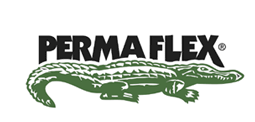
Asphalt Paving can be a difficult area of construction to understand. Most consumers deal with asphalt repairs, sealcoating, and striping on a fairly regular basis. But trying to find a competent paving contractor to perform a complete asphalt overlay of an existing property can be a tedious process. Some of the questions you may ask yourself: Why are all the quotes different? Why is this contractor repairing this area prior to overlay, and this contractor is not? Why is this contractor suggesting Perma Flex®, and this one is suggesting complete removal and replacement? Why are all the bids different, and why are their measurement quantities different?
To answer some of these questions is simple. There is always going to be more than one way to “fix it.” The answers cannot be completely cut and dry, but look for similarities in your bids; and if you are getting quotes for Perma Flex® always look for the trademark ® symbol and the logo.

For lack of a better comparison, asphalt is like baking a cake. There are several ingredients that if used in the correct quantities can produce an incredibly tasty treat. Altering these ingredients, or changing the amounts of certain ingredients, can severely affect the final product. Now most of us would know if someone used 8 cups of sugar and 12 eggs vs. 1 cup of sugar and 2 eggs to bake a cake, but the asphalt on your parking lot, obviously, is a completely different issue.
One
item consumers should understand is that the name Perma Flex® is the
only
trademarked asphalt mix design available. Never before has the asphalt
industry had a federally trademarked brandname attached to asphalt. Most
mixes, for example, are called “F” topping, “B”
binder, “A” base, etc. The Perma Flex® name became very
popular for two reasons: It works and it is a “catchy” name.
Without knowing the purpose or intent of the product, there are several
paving contractors selling the name without providing the real product.
If you are asking for the product by name, make sure the contractor is a “licensed Perma Flex® installer.” Their company name will appear on this website. And ask for a mix design. Simply put, and without getting too scientific, the design is:
100%
½ ”- ¾” Aggregate (rock)
0% Fines (sand)
4.5% Liquid AC20
If the aggregate (rock) in the Perma Flex® mix is very small (less than ½”) and it has lots of sand, you are not getting Perm Flex®. Perma Flex® is designed to go down no less than 1” in total thickness. The reason a contractor may use a mix design with smaller rock is so that he can install it at ¾” or ½” total thickness. This may be a surprise to consumers, but on a 10,000 square yard paving job this would save up to 275 tons of material. By the time you add up the materials, hauling time, and labor for additional time to install, etc., etc. this could save the contractor thousands of dollars at your expense.
If
a contractor suggests other solutions such as milling or in-place reclamation,
these are acceptable, but not necessarily cost effective alternatives
to Perm Flex®. However, if a contractor suggests using a knock-off
name such as “super flex,” perma pave,” or metro flex”
as an asphalt overlay, then they are trying to offer you a product that
may be similar, but definitely not the same. Over 25 years of trials,
several modifications and hundreds of thousands of dollars have gone into
perfecting the Perma Flex® mix design to better perform as an asphalt
overlay system. To protect yourself and your property take the time to
insure you get what you pay for.